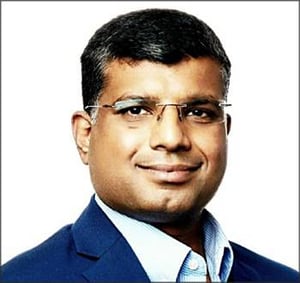Steve Rovniak: Can you share some background on your career before you joined Par Pacific as CIO?
 Sudhakar Virupakshi: Most recently, I was Vice President, Information Technology at a HollyFrontier, an oil and gas refinery based out of Dallas. I led multiple departments within IT, including architecture, corporate functions, integration, M&A–anything that was strategy driven. Prior to that, I was at Tesoro/Andeavor another oil and gas company based in San Antonio. I was there for about six years leading transformations, their strategic division for IT, and their business partnership function.
Sudhakar Virupakshi: Most recently, I was Vice President, Information Technology at a HollyFrontier, an oil and gas refinery based out of Dallas. I led multiple departments within IT, including architecture, corporate functions, integration, M&A–anything that was strategy driven. Prior to that, I was at Tesoro/Andeavor another oil and gas company based in San Antonio. I was there for about six years leading transformations, their strategic division for IT, and their business partnership function.
Do you have career experience in other industries?
Yes, I've been in multiple industries: pharmaceuticals, manufacturing, oil and gas, utilities, airline and fleet management. I've always led transformation efforts in core value chain and corporate functions. I feel that this broad experience has given me an all-around holistic approach, and helps me put myself into my partners’ and customers’ shoes.
Why were you interested to make a career move?
I am primarily a transformation leader. My passion is for simplifying an organization’s IT footprint and aligning IT and business strategy to enable technology-driven optimization. I was interested to make a career move to where I was head the information and operational technology, improve interoperability and bringing new synergies using technology into the energy sector.
What piqued your interest in Par Pacific and the role?
When I looked at Par Pacific and spoke to the executive team, it was very clear that they had a vision to grow and create an integrated portfolio-driven business to cater to local customers. I felt that my experience executing this model could help Par Pacific achieve that, and felt confident that I could create value by driving technology-enabled growth.
What was your job interview strategy?
My strategy was to focus the conversation on what we could accomplish together rather than what I had done in the past. Rather than walking them through my background, I asked them to tell me about their problems. “Here's where we are having challenges. What are your thoughts on it?" I think that approach changes the tone of the interview, and it worked out well for all of us.
What were some of the problems you heard?
How do we bring our Opex costs down? Are we right-sized as an organization? Do we need so many contractors? How do we hire more people with the right skills for the organization? And how do we make data more available for everybody in the business? These are some of the things that we discussed.
What do you think Par Pacific heard from you that impressed them the most?
There is a leading edge, and a bleeding edge in technology. I told them that I wanted to get foundational pieces right and run a leading-edge technology organization, not bleeding edge where we're going after things beyond our capabilities. I think that caught their eye, and of course my background in the oil and gas industry, my ability to discuss and understand the challenges we are facing in the industry today, in business terms, not just technology.
|
Related article: |
Did your career experience outside the oil and gas industry help you as a candidate?
Yes, that's a good point. When people say oil and gas, they think of it as one industry, but it's really not. It's a combination of three different industries. You have the refineries; that's purely manufacturing-based. Then you have the convenience stores and gas stations, which is a completely retail business, very comparable to a CPG. And then, in between, you have this logistics business—your trucks, your pipelines, your rail cars, your barges. Any one technology solution will not work for all three industries. You have to treat them as three different business units.
Who do you report to?
The Executive Vice President and CFO, who is also a Board member of the company.
What is the headcount in IT?
70 people including full-time employees and contractors.
How did you prepare to start your new role?
Before I officially started, I had the opportunity to regularly interact with my boss on things that we could do. We had a few conversations and I think that's a very healthy position to be in. Some people think that you show up on day one and that is the start of your job. But I think it is better to bring a mindset of “I can help you even before that," as long as there is not a conflict of interest with your previous employer. It is far better than drinking from a fire hose on your first day.
Once you’d officially started, what did you need to turn your attention to first?
The previous CIO had left about four months earlier, so there was a gap of four months without a CIO. During that time, the company had acquired a refinery on the West Coast and that integration was under way. So, there were a lot of things that were in play, and I knew that I had to hit the ground running. Security management needed to be put in place, and a good governance model was also needed.
What else?
From day one, I said that IT is not a cost center; IT is a value-generation engine that can optimize a lot of things. It was a different way of looking at it but we heard support from every part of the business, who said, "Yes, we need IT to be our trusted partner.”
We needed to align IT initiatives to business goals. What I observed was that there was a lot of speed, a lot of projects happening, a lot of demand. But when I looked closely, there was very little momentum in it because there was no clear direction or strategy behind it. IT was in a reactive mode.
So, I put several projects on hold that were not a priority at that point. We had to realign our resources and our capabilities and say," We are going to focus on these things." I would rather under-promise and over-deliver.
What else have you been working on during the past year?
We recently established a cybersecurity team and we have a much more successful security management process than before. We now have an architecture team that looks at acquisitions and also oversees all technology purchases. We have centralized all our procurement from an IT point of view. We have improved our SLAs so that, even with teams sitting here in Houston, in Seattle and in Hawaii, we have the ability to collaborate as “one team”.
We've made IT more function-driven so that we can really reap the benefits of IT partnering with the business. In the past, the organization was just two functions—applications and infrastructure. But we needed to add field operations and security as new dedicated functions, and I've hired leaders for all four of them.
We have been focused quite a bit on data analytics. I created a new team to be the reporting and analytics engine of the organization. In the past, it had been ad hoc.
Data is the life blood of an organization today, and we need to get our bare hands around what data we have, and how do we not only protect it, but also leverage it. There are really two schools of thought here. One school of thought says, "IT will do everything for you. You just give us the requirements and IT will prepare everything for you." That is the old school of thought. The new school of thought is, "IT is a data steward where we bring the data in. We consolidate it, we connect the dots and give it to you as content that is consumable. But as the business is the data owner and they build their own dashboards.
What has it been like to have COVID-19 rear its head in the middle of your first year as CIO?
It has been a very challenging moment in both the industry and the organization.
But as part of the leadership team, my approach was, "Yes, it's happening, but we should not panic because that's just going to ruin everything." The strategic plan, the three-year technology roadmap needs significant changes at this time. We have come up with ways for the entire organization to be remote without compromising on security.
About five or six days before the shutdown was starting to happen in New York, I spoke to the team and mentioned that " There is no way a Microsoft Teams rollout is going to be smooth because we have not tested it fully. But we need to roll it out today regardless, and iterate for the next couple of weeks.” I think that was a key decision that we made at that time. Fortunately, our technology footprint is strong. We had already strengthened our security and replaced a decentralized help desk operation with a global centralized 24/7 help desk. So, we were comfortable saying, "Let's go forward and make everybody work from home."
People picked it up really fast. I think everybody is a knowledge worker today. If you know how to use a smartphone, using Teams should not be that big of a deal, or Zoom for that matter.
What did you not have in place pre-Covid that you wish you had?
I wish we would have invested in VDI, the virtual desktop infrastructure, so it would not matter which computer people connect from; to give them one single way of connecting and working in a seamless environment. It gives you a little more control on data and people don’t have to store files on their personal computers.
Are there any silver linings to the COVID-19 experience?
IT has become the mainstay for the business. With a disruption of this nature, it would not be possible to hold down the fort and run the business without IT playing a key role. Before Covid, IT was a support function. Now, IT is helping drive the company forward. Not only do you have a seat at the table, you have influence.
Today, having a virtual meeting is normal for everyone. The trust in technology is there. People are confident that when they pick up that phone or connect to a Teams meeting, it will work. And they can get their jobs done in the most efficient manner. I have seen productivity increase during this time.
Have the pandemic and oil price wars affected your hiring plans?
We are still hiring. In the Houston market, the oil and gas hub, a lot of other companies have either laid off or furloughed people. So, we have a strong talent base from where we can pull the cream of the crop, which has been helpful.
Being so virtual now has tapped a whole new community of talent I did not have before. I mean, if I have to bring people to Houston, then we are paying for relocation. Now, I have the ability to say, "If you are in Idaho, no problem, you can stay there! You'll still be a valuable member of the team in IT."
Another silver lining!
That’s right. Attracting IT talent has not been a big problem for us at Par Pacific. We have good compensation, good work-life balance, and we rolled out a policy of unlimited vacation last year.
How do you know when your IT organization is succeeding?
You can have all the KPIs in the world, SLAs and everything. But it's not about your KPI’s or how much cost you can save. It's not about how many robotic process automations you have put in place. Ultimately, it comes to how much influence you have in the organization to help achieve its goals. That is the ultimate measure of your success.
What advice do you have for rising IT professionals who would one day like to join the technology “C” suite?
This is a question that is being asked a lot lately; “How do I grow my career in this market? How do I know I'm not hitting a ceiling?” Early in your career, nobody can tell you that you will be a CIO or a CTO or a CSO or Chief Digital Officer one day. You have to pick your path and stick with it. If you're a data person, you're a data person. If you're a security person, you're a security person. Work with your strengths as far as what your career progression is, and once you're at the top, then you can make a lateral move. But until you get there, you need to be focused on your pillar, and build on your strengths. I've seen people move horizontally at early stages of their career, and it destabilizes their path.
Any other final words of advice?
As technology executives, I think one of the biggest opportunities we have is to be the champions for revenue growth rather than cost savings. IT is not about cost savings. "I have a $200 million budget today. I'm going to cut it down to $180 million in two years." Great, that strategy may work some of the time. But if you say, “Company revenue is $6 billion and I want to help innovate to get it to $7 billion or $8 billion,” that is much more strategic. This is something that I have learned over the course of my career, and a mindset I bring to my work as a technology leader.
About Sudhakar Virupakshi
Sudhakar Virupakshi is the CIO at Par Pacific Holdings, Inc., which owns, manages and maintains interests in energy, related retailing and infrastructure businesses (NYSE: PARR, $5.4B). Virupakshi serves on advisory boards for Tardid Technologies, SYCUZ and VacationsXP. He earned an MBA from Bangalore University with specialization in finance, information technology and human resources.


Written by Steve Rovniak
Steve Rovniak served as Executive Director, Marketing and Media at Heller Search Associates from 2012 to 2023.



